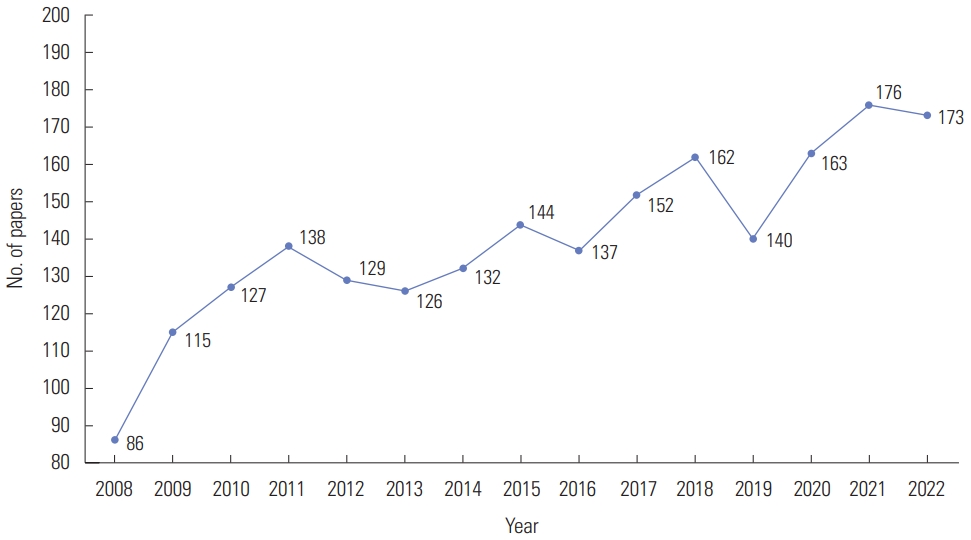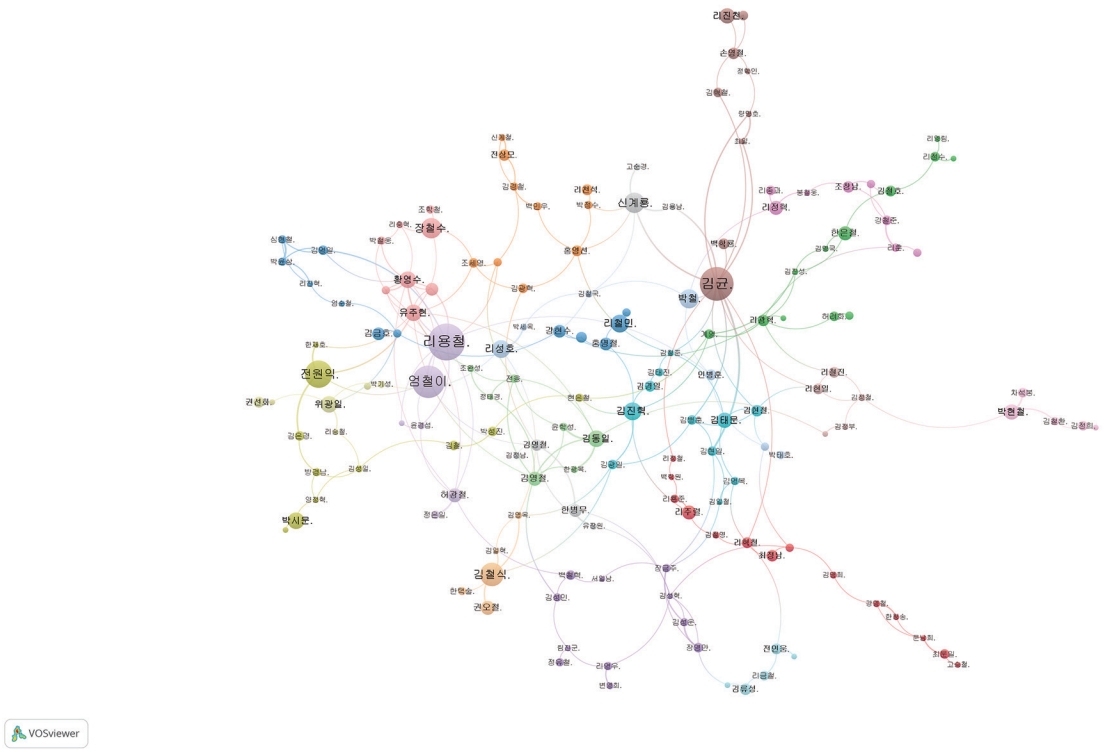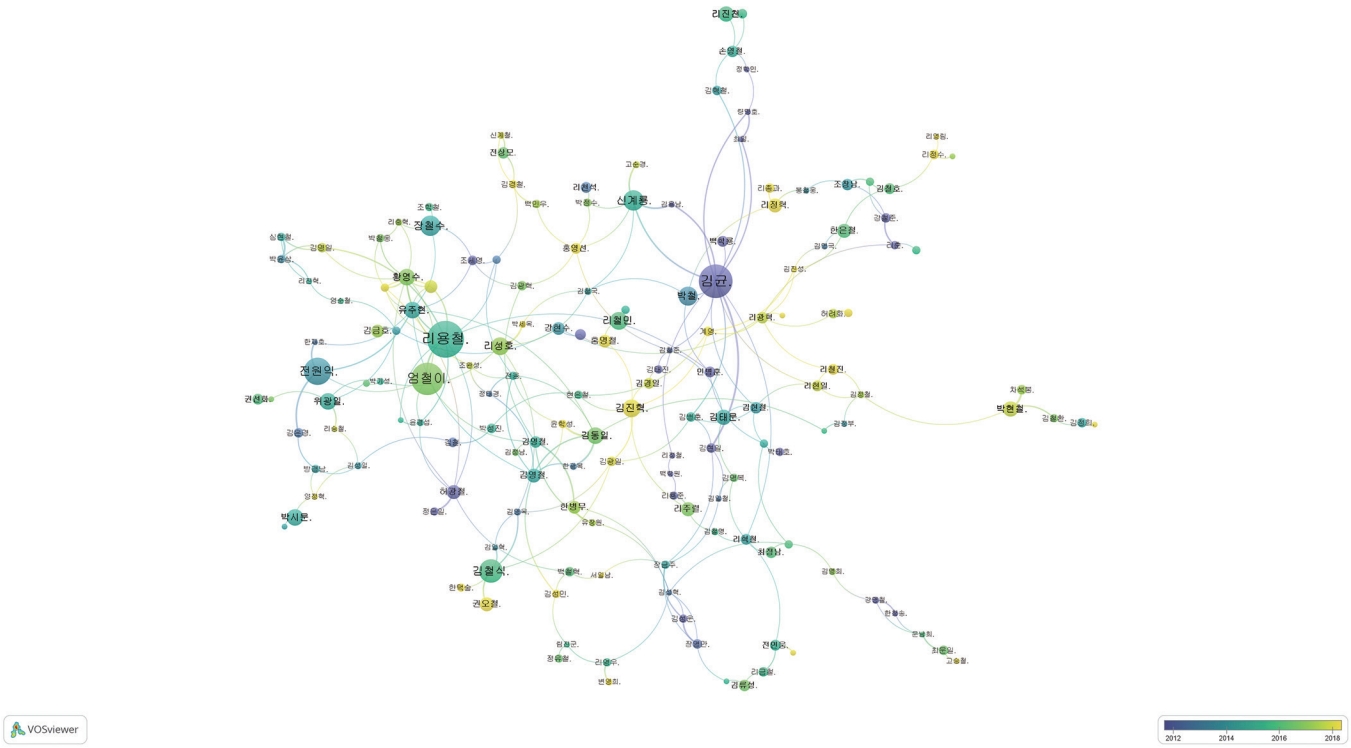Articles
- Page Path
- HOME > Sci Ed > Volume 11(1); 2024 > Article
-
Original Article
Co-authorship network analysis of North Korean chemistry researchers based on issues of Chemistry and Chemical Engineering published from 2008 to 2022: a bibliometric study -
Eunmi Park1
 , Ho-Yeol Yoon2
, Ho-Yeol Yoon2
-
Science Editing 2024;11(1):38-43.
DOI: https://doi.org/10.6087/kcse.329
Published online: February 20, 2024
1Office of Global Cooperation, Korea Research Institute of Chemical Technology (KRICT), Daejeon, Korea
2Strategic Technology Policy Center, Korea Research Institute of Chemical Technology (KRICT), Daejeon, Korea
- Correspondence to Ho-Yeol Yoon hoyeol@krict.re.kr
Copyright © 2024 Korean Council of Science Editors
This is an open access article distributed under the terms of the Creative Commons Attribution License (https://creativecommons.org/licenses/by/4.0/), which permits unrestricted use, distribution, and reproduction in any medium, provided the original work is properly cited.
- 799 Views
- 42 Download
Abstract
-
Purpose
- This study conducted a comprehensive analysis of North Korean domestic journals, using scientific quantification methodologies to identify prominent researchers and research areas within the field of chemistry.
-
Methods
- Data were collected from the journal Chemistry and Chemical Engineering published in North Korea. Through an analysis of co-authorship relations and literature reviews of papers authored by researchers who were highly influential in research networks, core research areas were identified.
-
Results
- The researcher with the highest number of publications in the given period was Yong-Chol Lee, with 31 publications, followed closely by Gyun Kim, who also demonstrated significant research activity. When focusing on the last 5 years, Myeong-Cheol Hong emerged as a prominent figure. Yong-Chol Lee has expertise across diverse fields of chemistry, including fine chemicals, biochemistry, and mineral materials. Gyun Kim, in contrast, is recognized for his in-depth knowledge of organics, enzymes, processes, catalysis, fine chemicals, and industrial chemistry. Myung-Cheol Hong’s research primarily centers around organic chemical synthesis within the fine chemical domain. All three researchers are making substantial contributions to the chemical industry.
-
Conclusion
- The findings of this study provide valuable insights into research trends in the field of chemistry in North Korea and contribute to a broader understanding of the discipline’s internal knowledge structure within the global academic community. This research is anticipated to be especially useful for scholars who are analyzing bibliographic information pertaining to North Korea.
- Background and rationale
- The Democratic People’s Republic of Korea (hereinafter North Korea) has attracted considerable attention from researchers analyzing bibliographic information [1–4]. This interest stems from its reputation as one of the most isolationist states, which has resulted in limited engagement with the global scientific community through publications in international scientific journals, particularly in the fields of science and technology. Despite North Korean leader Kim Jong-Un’s emphasis on the “knowledge economy” and the importance of science and technology, gaining insight into the scientific and technological landscape of North Korea remains a formidable challenge. This is due not only to the country’s restrictive information policies but also to the scarcity of digitized bibliographic data [5]. As a result, previous studies have predominantly relied on bibliographic databases for their analyses. Jeong and Huh [1] utilized data from the Web of Science to analyze bibliographic information, concluding that North Korean scientific research is primarily focused on the natural sciences. Kim and Chung [2] identified key researchers in the field of physics through an analysis of papers using Scopus data, noting a predominant emphasis on theoretical research in North Korean publications. Baxter et al. [4] investigated North Korea’s domestic nuclear research network, uncovering a pattern of research dissemination that revolves around central researchers and communities.
- While numerous studies have analyzed scientific and technological information in North Korea, the field of chemistry has not been as thoroughly examined. North Korea is developing an industrial system focused on alternative energy, domestically sourced raw materials, and indigenous technology in response to intensifying international sanctions. Considering the critical importance of chemistry in this scenario, understanding research trends in North Korean chemistry is valuable not only for informing responses to international sanctions but also for shedding light on developments within the industrial sector, since chemistry is a fundamental industry.
- Objectives
- In this study, we obtained and analyzed data from the North Korean domestic journal Chemistry and Chemical Engineering to understand trends in North Korean chemistry research. North Korean domestic journals that focus on the field of chemistry include Chemistry and Chemical Engineering, Science Academy Bulletin, and Kim Il Sung Comprehensive University Bulletin. While other academic journals cover a broader spectrum of natural sciences and engineering, including some aspects of chemistry, Chemistry and Chemical Engineering is a scholarly journal specifically dedicated to various fields within chemistry. It emphasizes disciplines such as inorganic chemistry, organic chemistry, polymer chemistry, physical chemistry, biochemistry, fuel chemistry, computational chemistry, and chemical engineering [6]. Most of North Korea’s scientific publications are concentrated in domestic journals [1]. Therefore, this research is expected to aid international researchers in gaining insights into North Korea’s domestic knowledge structure and research trends.
Introduction
- Ethics statement
- This study did not involve human subjects, and Institutional Review Board approval was not required.
- Study design and setting
- This was a bibliometric study based on the literature in a North Korean domestic journal. We collected bibliographic information from the North Korean domestic journal Chemistry and Chemical Engineering to achieve our research objectives. This journal, published internally in North Korea, contains academic papers featuring the experimental design, results, and references. We collected data in PDF format and converted the data into Microsoft Excel file (Microsoft Corp) for analysis purposes. This conversion was necessary because North Korea’s domestic journals are not organized in the same manner as international journal databases [4].
- Data sources and measurement
- The North Korean Science and Technology Information Platform (NK TECH; Korean Institute of Science and Technology Information [KISTI], Seoul, Korea), which collects information related to North Korean science and technology, includes data up to 2007 for verification and analysis, but no data have been collected since then. To analyze recent trends in the field of North Korean chemistry, we collected papers from 2008 to 2022.
- Due to the inability to gather comprehensive bibliographic information from databases like Web of Science and Scopus, we examined the central figures in the field through co-authorship network analysis. For this purpose, we employed VOSviewer ver. 1.6.18 (Centre for Science and Technology Studies, Leiden University), a software tool designed for literature analysis. In scenarios where information is scarce, visualizing subnetworks such as co-authorship can provide more insight than traditional bibliometric methods like citation analysis [7]. To further mitigate the constraints of limited bibliographic data, we performed a detailed literature review of publications by the key researchers we had identified. This review was carried out by PhD-level experts in chemistry, who meticulously examined individual papers to compensate for the incomplete bibliographic records. Although advanced literature analysis techniques, such as text mining, have been introduced, manual literature reviews by subject matter experts remain invaluable for grasping the essential substance and context of the literature.
- Statistical analysis
- Descriptive statistics were presented.
Methods
- From 2008 to 2022, a total of 2,100 papers have been published in North Korea’s Chemistry and Chemical Engineering journal. As seen in Fig. 1, there is year-to-year variability, yet an overall increasing trend is apparent. This is consistent with findings from previous studies that utilized international journal databases, which indicate a steady rise in the number of scientific and technological papers originating from North Korea [1,2,7,8]. Although there may be fluctuations across different research fields, the expectation is that there will be a continued growth in the volume of both domestic and international scientific and technological publications from North Korea.
- The author with the highest number of published papers is Yong-Chol Lee. Affiliated with the Hamhung Branch Institute of Inorganic Chemistry, Yong-Chol Lee authored 31 papers during the analysis period (Suppl. 1). Following closely behind, Gyun Kim, the Vice President of Kim Il Sung University, published 28 papers (Suppl. 2), while Cheol-I Eom contributed 27 papers (Suppl. 3). Fig. 2 illustrates the co-authorship network map for the field of chemistry in North Korea. For an efficient visualization of the network, only researchers who authored at least five papers were included.
- The researcher with the most connections is Gyun Kim. In Fig. 2, the size of the nodes indicates the number of papers published, while the thickness of the links reflects the strength of the connections between researchers. The figure reveals a knowledge structure in which a small number of key researchers are connected to a larger network through a limited set of papers. Research in North Korea tends to be more team-oriented, as opposed to studies conducted by individual researchers [5]. As a result, researchers such as Yong-Chol Lee and Gyun Kim occupy central roles within the network. Furthermore, Yong-Chol Lee and Gyun Kim are at the core of distinct research clusters. Cheol-I Eom is part of the same research cluster as Yong-Chol Lee.
- To understand the primary research areas within the field of chemistry in North Korea, a bibliographic analysis of the papers authored by Yong-Chol Lee and Gyun Kim is necessary. These individuals are recognized as prominent scientists in the NK TECH database maintained by the KISTI service [6]. Table 1 lists the affiliations and the number of publications for the top 10 researchers over the analysis period (Suppl. 5). However, despite the efforts of KISTI, the affiliations of certain researchers remain unclear.
- Fig. 3 illustrates the temporal distribution of co-author network map depicted in Fig. 2. Darker shades represent a greater number of publications in the earlier years of the analysis, such as 2008, while lighter shades correspond to more recent years, like 2022. Yong-Chol Lee’s research is predominantly from the mid-phase of the analysis period, whereas Gyun Kim’s work is largely from the initial phase. In contrast, Cheol-I Eom has consistently contributed papers up to the present. Focusing on the last 5 years, Myeong-Cheol Hong emerges as particularly notable. As a faculty member in the Department of Automation Chemistry at Sinuiju Light Industry University, Myeong-Cheol Hong also leads the computer control engineering course within the Department of Mechanical Engineering. Over the entire span of the analysis, Myeong-Cheol Hong has authored a total of 11 papers (Suppl. 4).
- In light of these findings, we conducted a detailed literature analysis, reviewing the papers authored by Yong-Chol Lee, Gyun Kim, and Myeong-Cheol Hong. Some chemical terms are used differently in North Korea compared to Korea, although both countries use the Korean language. Our analysis was based on reliable prior research on North Korean chemical terminology [9]. Yong-Chol Lee primarily focuses on electrochemistry as it relates to practical production and catalytic technology. He is an expert in various fields of chemistry, including the application of oxidation and reduction in the production of fine chemical products, as well as in biochemistry and photomaterials. His papers are structured to present concepts that are ready for practical application in actual processes. Gyun Kim is recognized as a researcher with a comprehensive understanding of organic chemistry, enzymes, processes, catalytic reactions, fine chemistry, and industrial chemistry. He specializes in reaction rates and the elucidation of reaction pathways. His expertise covers a wide range of fields, and he is acknowledged as a key contributor to the synthesis of essential substances and technological advancements in the field of fine organic chemistry, which involves using chemical reactions to synthesize materials vital to everyday life. MyeongCheol Hong, with his grasp of organic theoretical chemistry and the application of simplified molecular thermodynamics, optimizes reaction conditions through experimentation. He has demonstrated expertise in the synthesis of organic compounds within the fine chemistry field, contributing to the creation of industrially important substances such as dyes and disinfectants.
Results
- Key results
- North Korea has consistently endeavored to advance its chemical technology capabilities as a strategy to circumvent international sanctions, achieve scientific and technological self-reliance, and reduce dependence on external resources. Consequently, there has been a steady increase in the number of domestic chemistry publications, with a particularly sharp rise since Kim Jong-Un assumed power in 2012. Historically, Yong-Chol Lee was a prominent researcher in North Korea’s field of chemistry. More recently, Myeong-Cheol Hong has gained prominence. While Yong-Chol Lee’s work primarily focused on practical production methods, Myeong-Cheol Hong has concentrated on the field of fine chemistry, which is fundamental to industrial development.
- Interpretation
- This shift may indicate changes in the scientific and technological policies of the North Korean regime; however, a more detailed analysis is required in future studies [1]. North Korea’s science and technology policy appears to be a strategic response to national crises as well [10]. Additionally, as shown in Fig. 2, the lack of direct connections between early key researchers such as Yong-Chol Lee and Gyun Kim, and a later key researcher (Myeong-Cheol Hong), is a significant finding. While many studies that analyze research trends in specific fields focus on path dependency, the insular nature of North Korea suggests that path dependency may not be as important a factor. Investigating connections with research in the physical sciences, which are closely related to chemistry, could provide insightful outcomes [2]. Finally, although previous studies have emphasized research collaboration between North Korea and China, this study did not observe such trends in the analysis of domestic journals, indicating a valuable direction for future research.
- Limitations
- Although we investigated prominent researchers and research areas within North Korean chemistry, we were unable to identify the affiliations of certain researchers due to data limitations. The primary data source, Chemistry and Chemical Engineering, limits the availability of author information. To mitigate these constraints, we supplemented our research with external data sources, including the NK TECH. We anticipate that this paper will lay the groundwork for future studies in North Korean chemistry.
- Suggestions for further studies
- Although this study offers valuable insights, there are potential challenges to data integrity arising from the use of information translated from North Korean. This indicates that future efforts, possibly led by reputable institutions, should concentrate on creating an official personal name dictionary to maintain the integrity of the data.
Discussion
-
Conflict of Interest
No potential conflict of interest relevant to this article was reported.
-
Funding
The authors received no financial support for this work.
-
Data Availability
The raw data analyzed in this article was obtained in the course of a project on North Korea at the Korea Research Institute of Chemical Technology (KRICT; Daejeon, Korea). The raw data are available from the corresponding author upon reasonable request as the raw data are not allowed to be shared according to KRICT policy.
Notes
Supplementary Materials
- 1. Jeong GH, Huh S. Bibliometric analysis of publications from North Korea indexed in the Web of Science Core Collection from 1988 to 2016. Sci Ed 2017;4:24-9.https://doi.org/10.6087/kcse.85. Article
- 2. Kim K, Chung Y. Bibliographic and content analysis of physics papers from North Korea indexed in the Scopus from 2005 to 2018. Sci Ed 2019;6:35-40.https://doi.org/10.6087/kcse.153. Article
- 3. Shelton RD, Lewison G. Scientific collaboration as a window and a door into North Korea. Scientometrics 2013;97:3-11.https://doi.org/10.1007/s11192-012-0946-8. Article
- 4. Baxter P, Hastings JV, Kim P, Yim MS. Mapping the development of North Korea’s domestic nuclear research networks. Rev Policy Res 2022;39:219-46.https://doi.org/10.1111/ropr.12462. Article
- 5. Kim E, Kim ES. A critical examination of international research conducted by North Korean authors: increasing trends of collaborative research between China and North Korea. Scientometrics 2020;124:429-50.https://doi.org/10.1007/s11192-020-03461-1. Article
- 6. North Korean Science and Technology Information Platform (NK TECH). NK TECH [Internet]. Korean Institute of Science and Technology Information (KISTI); c2015 [cited 2023 Dec 12]. Available from: http://203.250.213.162/main/main.jsp.
- 7. Choi HW, Choi YJ, Kim S. Network analysis of scientific collaboration in North Korea. Sci Ed 2019;6:25-34.https://doi.org/10.6087/kcse.152. Article
- 8. Jeong GH, Huh S. Bibliometric and content analysis of medical articles in the PubMed database published by North Korean authors from 1997 to July 2017. Sci Ed 2017;4:70-5.https://doi.org/10.6087/kcse.98. Article
- 9. Park E, Ko Y, Choe H. A study on the terminological heterogeneity in chemistry between South and North Korea. Asian J Innov Policy 2021;10:294-315.https://doi.org/10.7545/ajip.2021.10.3:294. Article
- 10. Yoon J, Park HW. Pattern and trend of scientific knowledge production in North Korea by a semantic network analysis of papers in journal titled technological innovation. Scientometrics 2020;124:1421-38.https://doi.org/1007/s11192-020-03497-3. Article
References
Figure & Data
References
Citations


 KCSE
KCSE



 PubReader
PubReader ePub Link
ePub Link Cite
Cite




